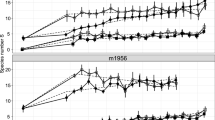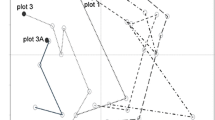Abstract
Priority effects provide an advantage to early establishing species and are thought to significantly affect the course of succession. We conducted a 20-year long experiment sowing high- and low-diversity mixtures in an ex-arable field. We ask how long the effect of sowing persists and which sown species affect the course of succession. The experiment was established in the Czech Republic in five replicate blocks, each containing three random 10 × 10 m plots with three treatments: natural colonisation, sowing low- and high-diversity seed mixtures. The species cover was annually estimated in 12 permanent 1 m2 quadrates within each plot. To identify the effects of sowing, we used an innovative method analysing the data separately for each year using Redundancy analysis (RDA) with identity of sown species as explanatory variables. In the first year, the effect of sowing was small; the peak of explained variability occurred between third and fifth year. The legacy of sowing was detectable in the natural colonisers for 18 years and in the sown species for the whole 20-year period. For some species, the difference between the plots where they were and were not sown remained significant for the whole 20-year period (e.g. Lathyrus pratensis) although the plots were adjacent and the area was mown with the same machine. Other ones (e.g. Trisetum flavescens) colonised all the plots evenly. The long-lasting effect of the initial sowing confirms contingency of successional pathway on the propagule pressure in the time of start of succession due to the priority effects.


Similar content being viewed by others
References
Bezemer TM, van der Putten WH (2007) Ecology: diversity and stability in plant communities. Nature 446:E6–E7. https://doi.org/10.1038/nature05749
Chase JM (2003) Community assembly: when should history matter? Oecologia 136:489–498. https://doi.org/10.1007/s00442-003-1311-7
Clements FE (1916) Plant succession: an analysis of the development of vegetation. Carnegie Institute of Washington, Washington
Cornelissen JHC, Lavorel S, Garnier E, Díaz S, Buchmann N, Gurvich DE, Reich PB, ter Steege H, Morgan HD, van der Heijden MGA, Pausas JG, Poorter H (2003) A handbook of protocols for standardised and easy measurement of plant functional traits worldwide. Aust J Bot 51:335–380. https://doi.org/10.1071/BT02124
Drake JA (1991) Community-assembly mechanics and the structure of an experimental species ensemble. Am Nat 137:1–26. https://doi.org/10.1086/285143
Drouin P, Prévost D, Antoun H (1996) Classification of Bacteria nodulating Lathyrus japonicus and Lathyrus pratensis in Northern Quebec as Strains of Rhizobium leguminosarum biovar viciae. Int J Syst Bacteriol 46:1016–1024. https://doi.org/10.1099/00207713-46-4-1016
Dutoit T, Gerbaud É, Buisson É, Roche P (2003) Dynamics of a weed community in a cereal field created after ploughing a semi-natural meadow: roles of the permanent seed bank. Écoscience 10:225–235. https://doi.org/10.1080/11956860.2003.11682770
Egler FE (1954) Vegetation science concepts I. Initial floristic composition, a factor in old-field vegetation development with 2 figs. Vegetatio Acta Geobot 4:412–417. https://doi.org/10.1007/BF00275587
Facelli JM, Facelli E (1993) Interactions after death: plant litter controls priority effects in a successional plant community. Oecologia 95:277–282. https://doi.org/10.1007/BF00323500
Fibich P, Vítová A, Lepš J (2018) Interaction between habitat limitation and dispersal limitation is modulated by species life history and external conditions: a stochastic matrix model approach. Community Ecol 19:9–20. https://doi.org/10.1556/168.2018.19.1.2
Fry EL, Pilgrim ES, Tallowin JRB, Smith RS, Mortimer SR, Beaumonth DA, Simkin J, Harris SJ, Shiel RS, Quirk H, Harrison KA, Lawson CS, Hobbs PJ, Bardgett RD (2017) Plant, soil and microbial controls on grassland diversity restoration: a long-term, multi-site mesocosm experiment. J Appl Ecol 54:1320–1330. https://doi.org/10.1111/1365-2664.12869
Fukami T (2015) Historical contingency in community assembly: integrating niches, species pools, and priority effects. Annu Rev Ecol Evol S 46:1–23. https://doi.org/10.1146/annurev-ecolsys-110411-160340
Fukami T, Bezemer TM, Mortimer SR, van der Putten WH (2005) Species divergence and trait convergence in experimental plant community assembly. Ecol Lett 8:1283–1290. https://doi.org/10.1111/j.1461-0248.2005.00829.x
Grubb PJ (1977) The maintenance of species-richness in plant communities: the importance of the regeneration niche. Biol Rev 52:107–145. https://doi.org/10.1111/j.1469-185X.1977.tb01347.x
Hansson M, Fogelfors H (1998) Management of permanent set-aside on arable land in Sweden. J Appl Ecol 35:758–771. https://doi.org/10.1046/j.1365-2664.1998.355350.x
Harmer R, Peterken G, Kerr G, Poulton P (2001) Vegetation changes during 100 years of development of two secondary woodlands on abandoned arable land. Biol Conserv 101:291–304. https://doi.org/10.1016/S0006-3207(01)00072-6
Hedlund K, Regina IS, van der Putten WH, Lepš J, Díaz T, Korthals GW, Lavorel S, Brown VK, Gormsen D, Mortimer SR, Rodríguez-Barrueco C, van Dijk C (2003) Plant species diversity, plant biomass and responses of the soil community on abandoned land across Europe: idiosyncrasy or above-belowground time lags. Oikos 103:45–58. https://doi.org/10.1034/j.1600-0706.2003.12511.x
Huston MA (1997) Hidden treatments in ecological experiments: re-evaluating the ecosystem function of biodiversity. Oecologia 110:449–460. https://doi.org/10.1007/s004420050180
Jongepierova I, Mitchley J, Tzanopoulos J (2007) A field experiment to recreate species rich hay meadows using regional seed mixtures. Biol Conserv 139:297–305. https://doi.org/10.1016/j.biocon.2007.07.026
Kiehl K, Kirmer A, Donath TW, Rasran R, Hölzel N (2010) Species introduction in restoration projects—evaluation of different techniques for the establishment of semi-natural grasslands in Central and Northwestern Europe. Basic Appl Ecol 11:285–299. https://doi.org/10.1016/j.baae.2009.09.002
Kleyer M, Bekker RM, Knevel IC, Bakker JP, Thompson K, Sonnenschein M, Poschlod P, van Groenendael JM, Klimeš L, Klimešová J, Klotz S, Rusch GM, Hermy M, Adriaens D, Boedeltje G, Bossuyt B, Dannemann A, Endels P, Götzenberger L, Hodgson JG, Jackel A-K, Kühn I, Kunzmann D, Ozinga WA, Römermann C, Stadler M, Schlegelmilch J, Steendam JH, Tackenberg O, Wilmann B, Cornelissen JHC, Eriksson O, Garnier E, Peco B (2008) The LEDA traitbase: a database of life-history traits of Northwest European flora. J Ecol 96:1266–1274. https://doi.org/10.1111/j.1365-2745.2008.01430.x
Klimešová J, Danihelka J, Chrtek J, de Bello F, Herben T (2017) CLO-PLA: a database of clonal and bud bank traits of Central European flora. Ecology 98:1179. https://doi.org/10.1002/ecy.1745
Körner C, Stöcklin J, Reuther-Thiébaud L, Pelaez-Riedl S (2008) Small differences in arrival time influence composition and productivity of plant communities. New Phytol 177:698–705. https://doi.org/10.1111/j.1469-8137.2007.02287.x
Kubát K, Hrouda L, Chrtek J Jr., Kaplan Z, Kirschner J, Štěpánek J (2002) Klíč ke květeně České republiky [Key to the Flora of the Czech Republic ]. Academia, Praha
Lang M, Hanslin HM, Kollmann J, Wagner T (2017) Suppression of an invasive legume by a native grass—High impact of priority effects. Basic Appl Ecol 22:20–27. https://doi.org/10.1016/j.baae.2017.06.005
Lanta V, Lepš J (2009) How does surrounding vegetation affect the course of succession: a 5-year container experiment. J Veg Sci 20:686–694. https://doi.org/10.1111/j.1654-1103.2009.01061.x
Lepš J, Brown VK, Len TAD, Gormsen D, Hedlund K, Kailová J, Korthals GW, Mortimer SR, Rodríguez-Barrueco C, Roy J, Regina IS, van Dijk C, van der Putten WH (2001) Separating the chance effect from other diversity effects in the functioning of plant communities. Oikos 92:123–134. https://doi.org/10.1034/j.1600-0706.2001.920115.x
Lepš J, Doležal J, Bezemer TM, Brown VK, Hedlund K, Igual Arroyo MI, Jörgensen HB, Lawson CS, Mortimer SR, Geldart AP, Rodríguez-Barrueco C, Regina IS, Šmilauer P, van der Putten WH (2007) Long-term effectiveness of sowing high and low diversity seed mixtures to enhance plant community development on ex-arable fields. Appl Veg Sci 10:97–110. https://doi.org/10.1658/1402-2001(2007)10%5b97:LEOSHA%5d2.0.CO;2
Manninen S, Aaltonen H, Kanerva T, Rämö K, Palojärvi A (2010) Plant and soil microbial biomasses in Agrostis capillaris and Lathyrus pratensis monocultures exposed to elevated O3 and CO2 for three growing seasons. Soil Biol Biochem 42:1967–1975. https://doi.org/10.1016/j.soilbio.2010.07.017
Martin LM, Wilsey BJ (2012) Assembly history alters alpha and beta diversity, exotic-native proportions and functioning of restored prairie plant communities. J Appl Ecol 49:1436–1445. https://doi.org/10.1111/j.1365-2664.2012.02202.x
Mitchley J, Jongepierová I, Fajmon K (2012) Regional seed mixtures for the re-creation of species-rich meadows in the White Carpathian Mountains: results of a 10-year experiment. Appl Veg Sci 15:253–263. https://doi.org/10.1111/j.1654-109X.2012.01183.x
Pakeman RJ, Pywell RF, Wells TCE (2002) Species spread and persistence: implications for experimental design and habitat re-creation. Appl Veg Sci 5:75–86. https://doi.org/10.1658/1402-2001(2002)005%5b0075:SSAPIF%5d2.0.CO;2
Plückers C, Rascher U, Scharr H, von Gillhaussen P, Beierkuhnlein C, Temperton VM (2013) Sowing different mixtures in dry acidic grassland produced priority effects of varying strength. Acta Oecol 53:110–116. https://doi.org/10.1016/j.actao.2013.09.004
Prach K, Fajmon K, Jongepierová I, Řehounková K (2015) Landscape context in colonization of restored dry grasslands by target species. Appl Veg Sci 18:181–189. https://doi.org/10.1111/avsc.12140
Prévosto B, Kuiters L, Bernhardt-Römermann M, Dölle M, Schmidt W, Hoffmann M, van Uytvanck J, Bohner A, Kreiner D, Stadler J, Klotz S, Brandl R (2011) Impacts of land abandonment on vegetation: successional pathways in European habitats. Folia Geobot 46:303–325. https://doi.org/10.1007/s12224-010-9096-z
Rejmánek M, van Katwyk KP (2004) Old field succession: a bibliographic review 1901–1991. Section of Evolution and Ecology, University of California, Davis. http://botanika.prf.jcu.cz/suspa/pdf/BiblioOF.pdf. Accessed 7 Dec 2018
Schamp BS, Aarssen LW, Piggott GSJ, Dante SK (2016) The impact of non-reproductive plant species on assessments of community structure and species co-occurrence patterns. J Veg Sci 27:668–678. https://doi.org/10.1111/jvs.12408
Sengl P, Magnes M, Weitenthaler K, Wagner V, Erdős L, Berg C (2017) Restoration of lowland meadows in Austria: a comparison of five techniques. Basic Appl Ecol 24:19–29. https://doi.org/10.1016/j.baae.2017.08.004
Šmilauer P, Lepš J (2014) Multivariate analysis of ecological data using CANOCO 5, 2nd edn. Cambridge University Press, Cambridge. https://doi.org/10.1017/cbo9781139627061.006
Švamberková E, Vítová A, Lepš J (2017) The role of biotic interactions in plant community assembly: what is the community species pool? Acta Oecol 85:150–156. https://doi.org/10.1016/j.actao.2017.10.011
ter Braak CJF, Šmilauer P (2012) Canoco reference manual and user´s guide: Software for ordination (Version 5.0). Microcomputer Power, Ithaca
Urban MC, de Meester L (2009) Community monopolization: local adaptation enhances priority effects in an evolving metacommunity. P R Soc B Bio Sci 276:4129–4138. https://doi.org/10.1098/rspb.2009.1382
Valkó O, Deák B, Török P, Kirmer A, Tischew S, Kelemen A, Tóth K, Miglécz T, Radócz S, Sonkoly J, Tóth E, Kiss R, Kapocsi I, Tóthmérész B (2016) High-diversity sowing in establishment gaps: a promising new tool for enhancing grassland biodiversity. Tuexenia 36:359–378. https://doi.org/10.14471/2016.36.020
van der Putten WH, Mortimer SR, Hedlund K, van Dijk C, Brown VK, Lepš J, Rodríguez-Barrueco C, Roy J, Len TAD, Gormsen D, Korthals GW, Lavorel S, Regina IS, Šmilauer P (2000) Plant species diversity as a driver of early succession in abandoned fields: a multi-site approach. Oecologia 124:91–99. https://doi.org/10.1007/s004420050028
Vellend M (2010) Conceptual synthesis in community ecology. Q Rev Biol 85:183–206. https://doi.org/10.1086/652373
Wilson JB, Gitay H, Rexburgh SH, King WM, Tangney RS (1992) Egler´s concept of ‘Initial floristic composition’ in succession—ecologists citing it do not agree what it means. Oikos 64:591–593. https://doi.org/10.2307/3545179
Acknowledgements
The research was supported by grant of the Czech Science Foundation (GAČR 31-17-05506S and 17-19376S). We thank dozens of students participating in vegetation recording, and farmer and plant ecologist Miroslav Šrůtek for hosting the experiment. We thank Jan W. Jongepier for language correction.
Author information
Authors and Affiliations
Contributions
JL conceived the ideas and designed the methodology; JL and JD supervised the experiment and collected the data with EŠ and many others; EŠ and JL analysed the data, EŠ has written the first draft of the manuscript. All authors contributed critically to the versions of the manuscript and gave final approval for publication.
Corresponding author
Ethics declarations
Conflict of interest
The authors declare that they have no conflict of interest.
Additional information
Communicated by Carly Stevens.
Electronic supplementary material
Below is the link to the electronic supplementary material.
Rights and permissions
About this article
Cite this article
Švamberková, E., Doležal, J. & Lepš, J. The legacy of initial sowing after 20 years of ex-arable land colonisation. Oecologia 190, 459–469 (2019). https://doi.org/10.1007/s00442-019-04415-y
Received:
Accepted:
Published:
Issue Date:
DOI: https://doi.org/10.1007/s00442-019-04415-y




